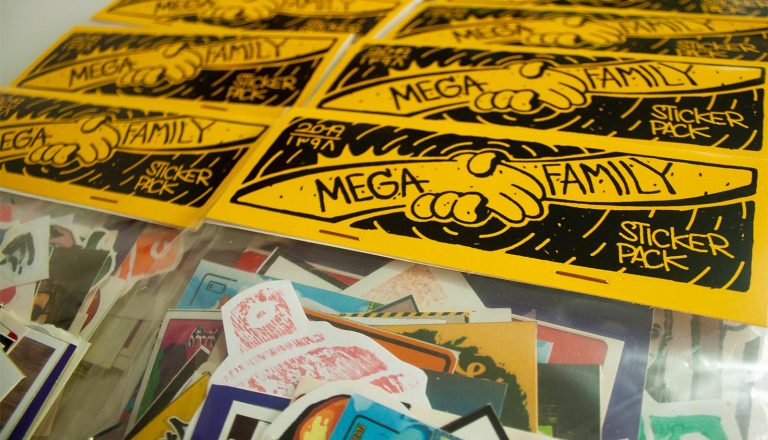
Street art in Iran social commentary on the streets of Tehran
They spray Tehran’s city walls with vibrant colors, oppose social injustice with visual provocation and defy the law with their artistic statements. In Iran, urban art is on the rise thanks to artists whose public work questions the country’s social and political status quo. We look at the street art of A1one, Icy and Sot, MAD and Nafir in an attempt to define their method.
Street Art in Iran Social Commentary on the Streets of Tehran
Wall painting boasts a long and complex history in Iran. After the Iranian Revolution in 1979, which abolished the rule of the Shah, the country was established anew as an Islamic Republic. Gigantic images of religious martyrs and heroes of the revolution began to adorn Tehran’s previously bare walls. Dominated by ideological narratives, public spaces became another place for political indoctrination and, gradually, a battlefield between state-sanctioned mural painters and independent street artists. Today, this gargantuan propaganda often labelled as urban beautification is faced with the challenge of much smaller, politically nuanced stencils, stickers and graffiti.
Tehran’s urban artists work constantly, stubbornly refusing to be silenced by the powers that be. Their visions illustrate the dichotomies of daily life in Iran: themes of war and peace, poverty and inequality, cultural identity and social injustice. While there is no organised movement of any sort, and all work is wiped off the walls within hours of its creation, these young artists demonstrate a stunning dedication to their own mission – whatever it may be.
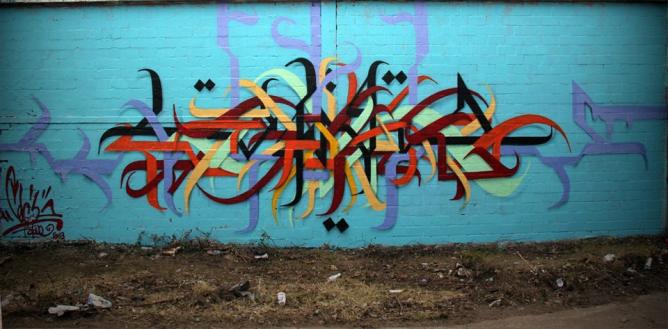
© A1one, courtesy of the artist
A1one
On his blog, A1one writes: ‘maybe I am a vandal or anarchist, but I am glad to introduce myself as one. I am not about politics (…)’. One of the longest-standing street artists in Tehran, A1one started painting the streets over ten years ago.
Though he produces astonishing stencil and sticker-based street portraits, freehand calligraphy has become his signature style. The walls he paints come alive with layers upon layers of Persian script, which overlap, silhouette and accentuate each other in a vivid allusion to the Persian technique of siyah mashq – an artistic process in classical calligraphy, whereby single symbols are constantly re-written until perfection. As a result, A1one’s finished images appear embossed, rich with a sense of history and heritage. A1one has recently broadened his portfolio to 3D graffiti models, where the sweeping curves of his calligraphy take on a palpable form and so formally embody both the wall and the symbol.
Many of his ‘calligraffiti’ works spell out the word ‘truth’ in Persian writing. By repeating ‘truth’ on the world’s walls, crafting its seemingly symmetrical yet complex curves and edges, spraying it on in myriad colors, A1one insists on exactly that – the truth.
Having left Iran for artistic reasons, he now resides in Germany.
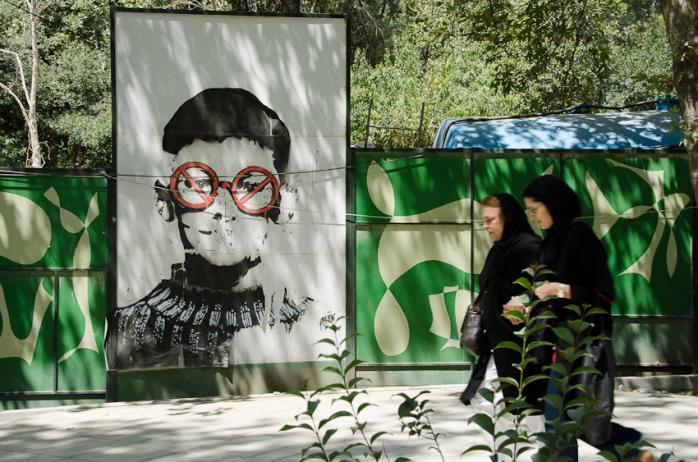
© Kamyar Adl
Icy and Sot
Arguably the most widely appreciated street artists to come out of Iran, brothers Icy and Sot are on a self-confessed ‘creative crusade to dismantle pre-conceived perceptions’ of Iran and its traditions. In doing so, they are also truth-seekers like A1one. They attest that ‘street art is a kind of political art, because it’s speaking directly to the people.’ And it is both to and about the people that the brothers talk through their art.
The figuration in Icy and Sot’s stencils extends beyond language. Women and children feature prominently in their work as vulnerable figures most prone to abuse and tragedy. Children are illustrated praying, hiding, walking alone, laboring – the imagery refers powerfully to the destruction of innocence, to injustice and disillusionment. Then there are the touching portraits of the elderly that lend a shape to the confrontation of tradition and modernity, the old and the new in Iran’s culture. And likewise, street art is a new form confronted with traditional preconceptions and prejudice. When they still lived in Tehran, Icy and Sot fought this, rendering the figures as part of Iranian society, natural elements of the lively traffic of people, cars and goods.
Icy and Sot have been displayed in galleries in New York, Berlin, Amsterdam and Milan, but the first time they ever attended one of their exhibitions was in 2012, when they were granted artistic visas to live in the USA. They have both been granted asylum since then.
MAD
Combining social commentary with a dose of humor and distance, MAD belongs to the ‘later’ generation of street artists. He creates almost uniquely stencil-based works, and sends his stencils to friends abroad (including Icy and Sot), who then spray them onto New York or Paris walls. MAD admits that although street artists have a tough life in Iran – they are regularly accused of Satanism and receive no support from artistic institutions – he still enjoys the purity of the whole situation, the fact that it has just been born. He also points out that there are many Iranians who do enjoy urban art, and who are eager to talk to the artist as he paints on yet another wall.
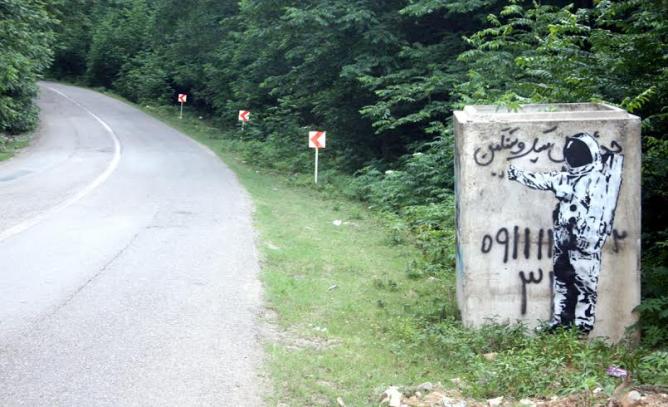
© MAD, courtesy of the artist
The peace symbol features prominently in various arrangements: taken away by two soldiers with their backs turned towards us, or serving as a support for three children who hold on to it with shy, hopeful smiles on their faces. The images speak for themselves in their integrity and spirit.
Street Art in Iran:Social Commentary on the Streets of Tehran

© MAD, courtesy of the artist
Nafir a.k.a. Scream
Nafir comes across as humble and modest. When asked to describe himself, he responds that there is nothing to be said; ‘I am just a scream on [a] wall’, he states. And there are more dichotomies to his identity: his butterfly logo is at once fleeting and charged with cultural power, its wings filled in with a heavy, ornate Persian pattern.
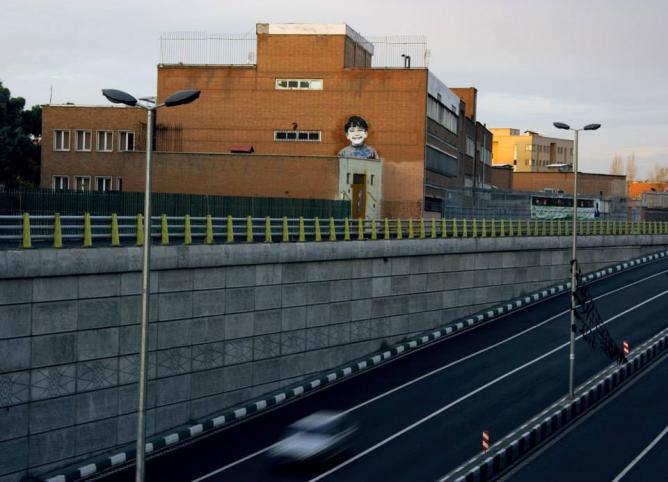
© Nafir, courtesy of the artist
Nafir’s stencils, too, are distinguished by their seeming disharmony: solemn scenes of loneliness and suffering are contrasted by a lightness of form and execution. Scarcely colored, the drawings use the wall’s color as a real element of their existence, giving the impression of dissolving into their own background. As many of his subjects are children, a clear message emerges: this is the lost, forgotten generation with a diminishing identity. But Nafir seems to counteract that by documenting their faces, in groups and alone, on all urban surfaces. His involvement in charity work and deep sense of empathy shine through these touching portraits; despair, melancholy, but also pure happiness flourish in Tehran with every new stencil.
تفسیر اجتماعی هنر خیابانی
آنها دیوارهای شهر تهران را با رنگ های تپنده اسپری میکنند، با آثار تحریک آمیز دیداری شان با بی عدالتی های اجتماعی مخالفت میکنند و با اظهارات هنرمندانه ی خود قانون را به مبارزه میطلبند.
در ایران، هنر شهری به کمک هنرمندانی که آثار آنها وضع اجتماعی و سیاسی کنونی کشور را مورد سوال قرار میدهد، درحال افزایش است. ما توضیحات کوتاهی از هنرمندان خیابانی ای که سعی دارند صدای دیداری خود را به گوش برسانند میدهیم.
نقاشی دیواری در ایران، تاریخ بلند و فراخی دارد. پس از انقلاب ایران در سال 1357 ، که حکومت شاه را برانداخت، کشور بطرز نوینی یک جمهوری اسلامی تأسیس کرد. تصاویر بزرگی از شهدای مذهبی و قهرمانان انقلاب شروع به آراستن دیوارهای عریان تهران کردند.
بر اساس گفته ها، اماکن عمومی تبدیل به جایی برای آموزش تعالیم سیاسی شدند و به تدریج یک میدان جنگ بین نقاشان دیواری که توسط دولت حمایت میشدند با هنرمندان خیابانی مستقل بوجود آمد. امروزه این تبلیغات عظیم که اغلب برچسب زیباسازی شهر به آن زده میشود، رقابت کمتری با استنسیل ها، استیکرهای چسبان و گرافیتی دارد.
هنرمندان شهر تهران دائما درحال کار هستند، و بطور سرسخت و لجوجانه ای از ساکت شدن توسط قدرت ها سر باز میزنند. دید آنها دوگانگی های زندگی روزانه در ایران را شرح میدهد. درحالیکه هیچ حرکت سازماندهی شده از هیچ نوعی وجود ندارد، و همه ی آثار در مدت چند ساعت بعد از خلق شدنشان پاک میشوند، این هنرمندان جوان فداکاری بسیار بزرگی برای مأموریت خود نشان میدهند.

© A1one, courtesy of the artist
(تنها) A1one
در وبلاگ خود نوشته است: ‘ ممکن است من یک خرابکار، یا یک آشوب طلب باشم، و خیلی هم خوشحال می شوم اگر یک خرابکار به حساب بیایم. من اهل سیاست نیستم. ‘
تنها که یکی از قدیمی ترین هنرمندان خیابانی در تهران است، از حدود ده سال پیش نقاشی کردن خیابان ها را آغاز کرد.
اگرچه او استنسیل ها و استیکرهای چسبان شگفت انگیزی از پرتره های خیابانی تولید میکند، اما دراصل خوش نویسی سبک نگارش او شده است. دیوارهایی که او روی آنها نقاشی میکند زنده میشوند، توسط لایه هایی از حروف فارسی که روی هم می افتند و یکدیگر را برجسته میکنند، بطوریکه اشاره ی واضحی به تکنیک فارسی سیاه مشق دارند. (سیاه مشق یک فرآیند هنری در خوشنویسی کلاسیک است که با آن حروف یک به یک بازنویسی میشوند تا کار تمام و کمال شود.) در نهایت تصاویر تکمیل شده ی a1one بسیار پرجلوه ظاهر میشوند، تصاویری که سرشار از یک حس تاریخی و موروثی هستند. A1one اخیرا مقام خود را به مدل های گرافیتی سه بعدی رسانده است، جایی که خطوط منحنی خوش نویسی او شکل ملموسی به خود میگیرند و از نظر شکل، هم به دیوار و هم به حروف جسم میدهند.
بسیاری از خوش نفیتی (خوشنویسی و گرافیتی) های او کلمه ی ‘حقیقت’ را در املای فارسی هجی میکنند. با تکرار کردن ‘حقیقت’ بر روی دیوارهای جهان، به زیبایی تمام و به شکل متقارن و در عین حال با خطوط منحنی و لبه های اریب پیچیده، و اسپری کردن آن با رنگ های بیشمار، a1one دقیقا بر همین پافشاری میکند – بر حقیقت.
او ایران را به دلایل هنری ترک کرده، و در آلمان زندگی میکند.

© Kamyar Adl
Icy and Sot
بدون شک دوتن از بزرگترین هنرمندان خیابانی که خروجشان از ایران بیش از پیش بر ارزش آنها افزوده است، برادران Icy and Sot هستند. آنها خود اقرار میکنند که یک نهضت خلاق برای خلع سلاح کردن باورهای از پیش جاافتاده ی ایران و سنت های آن هستند. در عمل نیز، مانند A1one حقیقت جو هستند. آنها معتقدند که ‘هنر خیابانی نوعی هنر سیاسی ست، زیرا مستقیما با مردم صحبت میکند.’ و این هنر هم برای، و هم درباره ی مردمی ست که این دو برادر به واسطه ی هنرشان از آنها حرف میزنند.
شکل ظاهری استنسیل های Icy and Sot تا ورای زبان ادامه می یابد. زنان وکودکان که مستعد سوء استفاده شدن و به بار آمدن فجایع بیشتری هستند، بخش اصلی کارهای آنها را تشکیل میدهند. کودکان درحال دعا کردن، پنهان شدن، تنها قدم زدن و کارگری هستند – اینها تصویرسازی های بزرگی هستند که بی گناهی و پاک بودن، بی عدالتی و سرخوردگی را نشان میدهند. در سویی دیگر، تصاویری از چهره ی افراد مسن و سالخورده وجود دارند که مواجهه ی سنت های قدیمی و نوگرایی را منتقل میکنند، یعنی فرهنگ قدیم و جدید ایران.
بعلاوه، هنر خیابانی شکل جدیدی ست که با باورهای جاافتاده ی قدیمی و تبعیض مواجه است. زمانیکه Icy and Sot هنوز در تهران زندگی میکردند، با تعبیر کردن اشکال بعنوان بخشی از جامعه ی ایرانی، عناصر طبیعی و جالب توجهی از عبور و مرور مردم، ماشین ها و کالاها، بااین باورها می جنگیدند. Icy and Sot در گالری هایی در نیویورک، برلین، آمستردام و میلان نمایش داده شده اند. اولین باری که آنها در یکی از نمایشگاه هایشان شرکت کردند سال 2012 بود، زمانیکه ویزای هنری برای زندگی در آمریکا به آنها اهدا شد. از آن پس به هردوی آنها پناهگاه و جایی برای زندگی اعطا شد.
MAD
او به نسل بعدی هنرمندان خیابانی تعلق دارد. MAD با ترکیب کردن نوشته های اجتماعی با مقداری شوخی و جدیت، آثار استنسیل منحصر به فردی خلق میکند، و برای دوستانش در خارج از کشور (شامل Icy and Sot ) میفرستد، و آنها این استنسیل ها را روی دیوارهای نیویورک یا پاریس اسپری میکنند. MAD میگوید هنرمندان خیابانی در ایران زندگی خشن و سختی دارند – آنها بطور مرتب به شیطان پرستی متهم میشوند و هیچ حمایتی از مؤسسه های هنری دریافت نمیکنند – اما او هنوز از پاک و خالص بودن این موقعیت لذت میبرد. او همچنین اشاره میکند، ایرانیان بسیاری وجود دارند که از هنر شهری لذت میبرند، کسانی که مشتاقند درحالیکه هنرمند دارد روی دیوار دیگری نقاشی میکند، بااو صحبت کنند.

© MAD, courtesy of the artist
نماد صلح توسط آثار مختلفی نشان داده میشود، در یکی از کارهای MAD ، دو سرباز آن را گرفته و درحال بردن هستند، درحالیکه پشت آنها به سمت ماست، و در کار دیگری در دست سه کودک است که آن را با خجالت نگه داشته اند و لبخند امیدوارانه ای به لب دارند. این تصاویر خودشان با تمامیت و بی نقصی و روحی که در آنهاست صحبت میکنند.

© MAD, courtesy of the artist
Nafir aka Scream
نفیر بعنوان فردی متواضع و فروتن شناخته شده است. وقتی از او خواستیم خودش را توصیف کند، او پاسخ داد: چیزی برای گفتن وجود ندارد، من فقط یک فریاد روی (یک) دیوار هستم. یکی از معروف ترین کارهای او، لوگوی پروانه ی اوست که بار فرهنگی زیادی دارد و بال هایش پر از طرح و نقش های پر آب و تاب فارسی ست.

© Nafir, courtesy of the artist
استنسیل های نفیر توسط عدم هماهنگی زیبایی که دارند تشخیص داده میشوند. چشم اندازهای مؤثری از تنهایی و رنج که هرکدام توسط شکل و اجرای درخشان شان با یکدیگر مقایسه میشوند. در این نقاشی ها، که به سختی رنگ میشوند، از رنگ دیوارها بعنوان عنصر اصلی استفاده میکنند، که اثر ناخوشایندی به زمینه ی آنها میدهد. از آنجاییکه بسیاری از موضوعات او را کودکان تشکیل میدهند، پیام واضحی نشان داده میشود : این نسلی گمشده و فراموش شده با هویتی درحال کاهش است. اما به نظر میرسد نفیر با جمع آوری تصاویری ازصورت های آنان بصورت گروهی و تکی، عملی متقابل با این را انجام میدهد. دخالت او در کارهای خیریه و حس عمیق همدلی اش، توسط این آثار تأثیرگذار او می درخشند؛ باوجود یأس و ناامیدی، مالیخولیا و غم زدگی، شادی محضی وجود دارد که با هر استنسیل جدید این هنرمند در تهران می شکفد.





